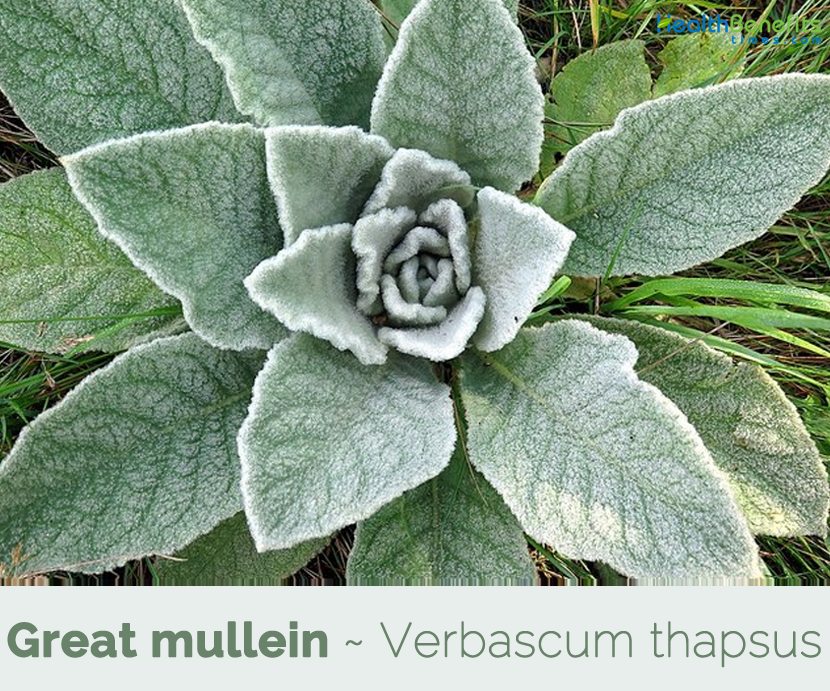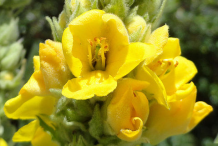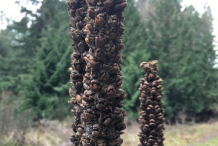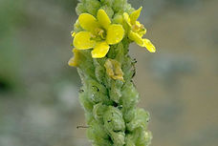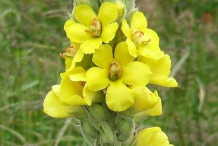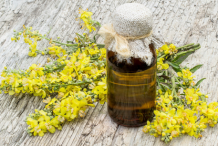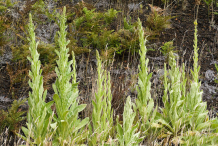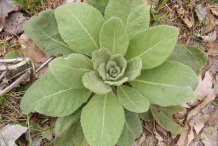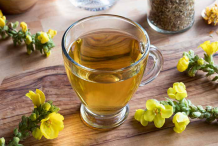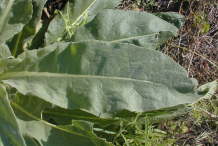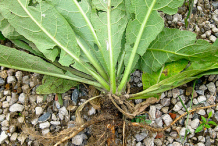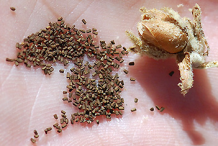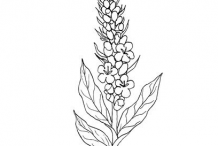| Great mullein Quick Facts |
| Name: |
Great mullein |
| Scientific Name: |
Verbascum thapsus |
| Origin |
Europe, north Africa and western and central Asia |
| Colors |
Brown |
| Shapes |
Hairy, egg-shaped, two-celled capsules. Capsules are 6 to 10 mm long |
| Taste |
Bitter, astringent |
| Health benefits |
Improving Digestive Issues, Treatment of tuberculosis, Treatment of cold and flu, Joint Pain and Rheumatism, Anti-bacterial effects, Relief from Sleeping Problems, Soothes Skin Conditions, Respiratory Ailments, Treating Asthma, Treating Ear Related Infections, Beneficial for lungs, Stop Smoking, Beneficial for the Bladder, Cures migraine and headaches, Beneficial in treating cramps |
Verbascum Thapsus, the great mullein or common mullein, is a species of mullein native to Europe, northern Africa, and Asia, and introduced in the Americas and Australia. It is a member of the Scrophulariaceae family of angiosperms. The genus name and several of the many common names for V. Thapsus refer to the dense wooly hairs that cover the surface of its leaves. The soft leaves also give rise to regional names such as ‘cowboy toilet paper’. The plant has a huge number of other names including Aaron’s rod, Adam’s flannel, beggar’s blanket, beggar’s stalk, blanket herb, bullock’s lungwort, candlewick plant, clot, clown’s lungwort, common mullein, cowboy toilet paper, Cuddy’s lungs, duffle, feltwort, flannel mullein, flannel plant, fluffweed, golden rod, hag’s taper, hare’s beard, Jacob’s staff, Jupiter’s staff, molene, Moses’ blanket, mullein, mullein dock, old man’s flannel, Our Lady’s flannel, Peter’s staff, rag paper, shepherd’s clubs, shepherd’s staff, torches, velvet dock, velvet plant, white mullein, wild ice leaf, woollen and woolly mullin.
It’s not related to lungwort, nor to the plant normally called neither goldenrod nor rose root, all of which belong to different botanical families. The genus name Verbascum was derived from the old Latin name for the species, barbascum, which means ‘bearded plant’. Thapsus was a city in what is now Tunisia. The common name, mullein, is derived from the Latin word mollis, which means ‘smooth or with soft hairs’. It is widely used for herbal remedies; the entire mullein plant can be used in a multitude of ways in remedies for respiratory health, lymphatic support, and musculoskeletal complaints. Mullein remedies are especially recommended for coughs and related problems, but also used in topical applications against a variety of skin problems. The plant has also been used to make dyes and torches.
Plant Description
Great mullein is a hairy, densely woolly, sturdy dicotyledonous biennial plant that grows more than 7 feet (2 m) tall. The plant is found growing abundant on dry, rocky hillsides, disturbed areas, open woodland, fence rows, old fields, pastures, limestone glades, rocky slopes and clay banks, pastures and fallow fields, areas along railroads and roadsides, vacant lots, and dry waste areas. The plant prefers dry sandy soil, but can be found in a variety of well-drained soils in meadows and forest gaps. The plant can tolerates a wide range of soil conditions, including poor soils, but must have good drainage. The plant has small and spindly, stout taproot that runs deep into the ground. It is gray-white in color with an earthy mineral flavor.
During its first year, it forms a low-growing rosette from a tap root. It has a dense yellow to white tomentose (stellate or dendritic) pubescence on the bluish grey-green leaves. Blades are obovate to oblanceolate, 8-50 cm long and 2.5-14 cm wide, with margins entire to shallowly crenate.
In its second year, it produces an erect flowering stem 30-200 cm tall. The lower stem leaves are petiolate. Leaf blades are oblanceolate-oblong to 15 cm long and 6 cm wide with crenate margins. Other stem leaves decrease in size up the stem, with the upper stem leaves oblanceolate, sessile, and decurrent into wings on the stem.
Flower
The central stem of the mullein plant ends in a dense spike of pale yellow flowers that generally measure anywhere from 5 to 60 cm (2inches to 2 feet) long. Each flower is about 2 cm (¾ inches) across and consists of five pale petals, five hairy green sepals, five stamens, and a pistil. The three upper stamens are covered with white or yellow hairs, while the two lower stamens are hairless. Flowering period usually occurs during the summer and lasts about six weeks. Only a few flowers are in bloom at any one given time. All parts of the plants are covered with star-shaped trichomes. This cover is particularly thick on the leaves, giving them a silvery appearance.
Fruit
Each flower is replaced by hairy, egg-shaped, two-celled capsules. Capsules are 6 to 10 mm long, split at maturity, and contain numerous seeds. The rectangular-oblong seeds have fine wavy ridges and tiny pits across the surface. While the foliage withers away, the central stalk and its seed capsules turn brown and continue through the winter. The seeds are small enough to be carried aloft by the gusts of wind that shake the central stalk. The rod-like spike of fruits often persists through the winter.
Health benefits of Great Mullein
Great Mullein is a versatile herb; it can be applied, drunk, smoked or inhaled for medicinal purposes. The mullein leaf and the flowers of the plant are used in tinctures, syrups, oils, and even used to gargle. Mullein oil can cure ear pain and is good for curing eczema; hemorrhoids and wounds. Mullein tea is good for stopping nonstop coughing. Listed below are few of the health benefits of great Mullein
1. Improving Digestive Issues
Drinking Mullein tea can help you deal with a number of digestive conditions and problems. It can provide relief to those suffering from diarrhea and constipation. It also helps cope with bowel related problems and help your body eliminate toxins easily.(1)
2. Treatment of tuberculosis
Mullein leaf extract was used as a treatment for tuberculosis in Europe as early as the 16th century. Research in the 18th century found that mullein relieved the symptoms of several tuberculosis patients at St. Vincent’s hospital in Birmingham, England. It was extensively believed that if mullein was used in initial stages of the disease, it could bring about a full recovery.
Today, scientific experiments and medical studies have shown that mullein has expectorant and anti-bacterial properties, both of which are essential for treating respiratory disorder.(2), (3)
3. Treatment of cold and flu
As mentioned earlier, mullein leaf extract has expectorant and anti-bacterial properties, which makes mullein tea a wonderful home remedy for flu or a cold with lots of congestion. According to medical researchers, saponins present in mullein give it its expectorant properties. It also helps to reduce the amount of mucus produced in body and decreases congestion.(4), (5)
4. Joint Pain and Rheumatism
There are numerous historic references on using mullein leaf externally on painful and rheumatic joints.
Recently, mullein root has become popularized for back pain. Herbalist states, “Mullein root on its own, though, is also markedly effective. Prepared either as an infusion or taken in small doses as a tincture. Normally take about seven drops of tincture, stretch out a bit, and the kink will disappears and you feel perfectly aligned. While the occasions when this has worked are too numerous to recount, it doesn’t always work…just most of the time. (6)
5. Anti-bacterial effects
Mullein consists of naturally occurring anti-bacterial properties. Mullein’s anti-bacterial behaviors make it useful in treating infections.
It has been used to treat tuberculosis as it prevents growth of mycobacterium, the bacteria which are the culprit behind this disease. Medical researchers have found that verbascoside works exceptionally well against Staph infections.(7)
6. Relief from Sleeping Problems
Insomnia is one of the popular growing issues amongst men and women belonging to various age groups. Instead of popping those OTC pills to doze off, you can option to Mullein tea to battle insomniac nights. It acts as a natural sedative and soothes your nerves. It is considered quite beneficial for overcoming sleeping problems.
7. Soothes Skin Conditions
Apart from Mullein tea, you can also use Mullein oil to get relief from a variety of skin conditions. It can work wonders on blisters, wounds and small cuts. In fact, you can apply Mullein leaf tea on sores and wounds externally too. It has a calming effect on the skin. Mullein combined with olive oil, can also be applied in such conditions for quick relief.
8. Respiratory Ailments
Having Mullein tea can help you combat a number of respiratory ailments and conditions like cold, cough and bronchitis. It can also offer relief from sore throats. Its anti-bacterial properties help cope with inflammation and infection.
Besides, it helps discard excess mucus from the throat and nasal passages. You may offer this tea to kids suffering from cold without worrying about any side effects. Apart from drinking the tea, you can also try gargling it two times a day to relieve sore throats.
9. Treating Asthma
Mullein tea is quite beneficial for people afflicted with asthma. You can drink the tea, or can even inhale the vapor of the plant leaves in hot water. It can also be beneficial when you are suffering from nasal congestion. You can even use the dried leaves of the herb to make herbal and harmless cigarettes!
10. Treating Ear Related Infections
According to various scientific researches, oil extracted from the flowers of mullein is rich in powerful anti-bacterial and anti-inflammatory properties. Therefore, it could be efficiently used as a natural cure for ear infections. It can also be used to ease the pain experienced in the ears due to sinus blocks.
11. Beneficial for lungs
Mullein leaf has long been adored for soothing the lungs and suppressing coughs. It is a mild relaxant to the lungs and also a mild demulcent. It calms inflammation and dryness – often the causes of irritation for people with smoke exposure. Additionally mullein flowers can have an added benefit to these dry irritated conditions.
12. Stop Smoking
Mullein leaf is commonly used by herbalists to aid those who want to quit smoking. It is frequently recommended to take the tea or tincture internally to support the health of the lungs, while concurrently using it as a smoking herb to assist with the desire to smoke something.
While it sounds a bit counterintuitive, inhaling mullein smoke is a way to directly get mullein’s relaxant qualities to the lungs, to relax constrictions and aid in stopping a cough. This method can be overdone, but when you get it just right it can have dramatic and quick results.
13. Beneficial for the Bladder
In addition to back pain, mullein root is also used to address a variety of urinary incontinence issues, including stress incontinence, pregnancy incontinence, menopausal incontinence, and childhood incontinence. It can also be used to assist those with interstitial cystitis and benign prostatic hyperplasia (BPH, enlarged prostate).
14. Cures migraine and headaches
Mullein flower extract, being rich in anti-inflammatory and analgesic properties, is used in alternative medicines as a cure for migraines and headaches. It can also be used to heal the headaches arising from ear oppression.
15. Beneficial in treating cramps
Mullein is well-known for its wonderful anti-spasmodic properties that make it a possible natural cure for stomach cramps induced by gastric upset as well as menstrual cramps. Its anti-inflammatory and analgesic properties ease the pain related with these conditions.
https://www.youtube.com/watch?v=Z8Z6YrtnMdw
Traditional uses and benefits of Great mullein
- Leaves can have stimulatory effects when smoked.
- Great mullein is a commonly used domestic herbal remedy, valued for its efficacy in the treatment of pectoral complaints.
- It acts by reducing the formation of mucus and encouraging the coughing up of phlegm, and is a specific treatment for tracheitis and bronchitis.
- Leaves and the flowers are anodyne, anti-inflammatory, antiseptic, antispasmodic, astringent, demulcent, diuretic, emollient, expectorant and vulnerary.
- An infusion is taken internally in the treatment of a wide range of chest complaints and also to treat diarrhea.
- Plant combines well with other expectorants such as coltsfoot and thyme.
- Poultice of the leaves is a good healer of wounds and is also applied to ulcers, tumors and piles.
- An infusion of the flowers in olive oil is used as earache drops, or as a local application in the treatment of piles and other mucous membrane inflammations.
- Decoction of the roots is said to alleviate toothache and also relieve cramps and convulsions.
- Juice of the plant and powder made from the dried roots is said to quickly remove rough warts when rubbed on them.
- It is not thought to be so useful for smooth warts.
- Seeds are slightly narcotic and also contain saponins.
- Poultice made from the seeds and leaves is used to draw out splinters.
- Decoction of the seeds is used to soothe chilblains and chapped skin.
- Homeopathic remedy is made from the fresh leaves.
- It is used in the treatment of long-standing headaches accompanied with oppression of the ear.
- It is used to treat Asthma, TB, Lungs Congestion and Pneumonia.
- Burns the dried leaves of Verbascum Thapsus, inhale the smoke, it will give relief from Nasal Congestion.
- It reduces swelling and inflammation of Joints.
- It cures severe pain caused by Sinus and Headache.
- It is useful in treating Insomnia and Anxiety. It lowers the levels of Cortisol and promotes sleep.
- It increases the body’s ability to fight against virus and germs.
- It is beneficial in treating diseases like Measles, Mumps and Chicken Pox.
- It is a good herbal remedy for fever as it lowers the body temperature.
- It tones the Bladder and is an effective remedy against bladder infection.
- It tones the digestive tract and enhances digestion.
- It is a good treatment for constipation. It is beneficial in treating diarrhea, intestinal worms and other gastrointestinal issues.
- Mullein tea is beneficial in treating cold, cough, bronchitis, flu, asthma and chills. It is an effective way of treating throat problems like sore throat and tonsillitis.
- Oil is effective in treating ear problems. It reduces pain due to ear infections and swelling. It helps in fighting the bacteria which causes Infection.
- It is used topically in curing skin problems like acne, eczema, burns and bruises. It is beneficial in treating skin ulcers and frostbite.
- It provides relief in painful menses. It reduces pain and improves the blood flow.
- Cradle Cap is a common problem in newborn babies. Mullein Oil is beneficial in getting rid of Cradle Cap.
- High amount of Vitamin B helps to fight hunger and prevents unnecessary eating. It helps you fight Obesity.
- It acts as a conditioner for rough and harsh hair. It reduces the problem of Split Ends.
- Catawbas made a cough syrup from boiled common mullein roots, and a poultice of mashed leaves was used to relieve bruises, wounds, and sprains.
- Early European settlers in the eastern United States used common mullein seed to sting or poison fish.
- Common mullein is one of several plants used in herbal ear drops used to treat earaches in children (>5 years).
- An infusion of the root is also used to treat athlete’s foot.
Ayurvedic Health benefits of Great mullein
- Snake Bite: Prepare infusion of Verbascum Thapsus leaves. Give it to the Victim.
- Fever: Prepare decoction of Verbascum Thapsus roots. Take 3 cups a day.
- Deafness: Put 2 drops of Verbascum Thapsus Oil in ears.
- Anemia: Prepare a decoction of Verbascum Thapsus leaves. Have it, once a day.
- Bed Wetting: Have Verbascum Thapsus tincture. OR : Have Mullein extract
- Breast Cancer: Take three tablespoon of Mullein and one tablespoon of Lobelia. Use it as a fomentation. Change the fomentation every day. Repeat this for one month.
- Lung Disorders: Make a tea of Fresh Leaves of Flowers. It will act as an expectorant and will clear the Lungs. OR Smoking steam of tea will help in Nasal congestion. OR Burn dried leaves and inhale the Smoke to get rid of nasal and lung congestion
- Bronchitis: Take Verbascum Thapsus, White Horehound, Coughwort and Lobelia. Prepare a decoction. Take two or three times a day.
- Cough: Take Verbascum Thapsus, Elder and Red Clover. Prepare a decoction. Take two or three times a day. OR have in the form of powder.
- Asthma: Take Verbascum Thapsus and Grindelia. Prepare decoction. Drink 2-3 times a day.
- Arthritis: Take one part Cayenne, 3 part Lobelia, 6 part Verbascum Thapsus and 9 part Slippery Elm bark. Put 6 tablespoons of this mixture in boiling water and make a thick paste. Coat the paste on a soft cloth and apply on the affected area.
- Respiratory Diseases: Mix equal quantities of powdered Ephedra, Comfrey, Verbascum Thapsus, Cherry, Licorice, Ginger, Cinnamon, Inula Helenium and Wild Ginger. Take 2-3 tablespoons throughout the day with warm water.
- Hemorrhoids: Prepare a strong mullein tea with two tablespoons of mullein flowers or leaves and one quart of water. Steep and cool it and make certain that you strain it scrupulously. Apply to affected areas two to three times a day or after urinating.
Culinary Uses
- An aromatic, slightly bitter tea can be made by infusing the dried leaves in boiling water for 5 – 10 minutes.
- Sweeter tea can be made by infusing the fresh or dried flowers.
Different methods of making Mullein Tea
If you want to make your own mullein tea, you will need either fresh or dried mullein leaves or flowers. If you have fresh leaves and flowers, lay them on a cookie sheet and cover them with cheesecloth. Be sure they are not exposed to moisture for 2-3 days until they are completely dry. Then, you are ready to brew some tea. Making tea with fresh mullein leaves is also possible, but will require more steeping time.
- Step 1 – Bring 2 cups of water to a boil in a saucepan.
- Step 2 – Pour hot water over 2 teaspoons of dried mullein leaves, as well as 2-3 dried flowers.
- Step 3 – Allow the tea to steep for 8-10 minutes.
- Step 4 – Strain the tea through cheesecloth to remove any leaves or flower particles.
- Step 5 – Add honey, if desired, to improve the flavor of the tea.
Mullein tea recipe to soothe coughs
Ingredients:
- One ounce of mullein leaves or flowers
- 1 ounce flowers of calendula plant
- Quarter ounce marsh-mallows
- Half ounce of licorice root
Brew the tea as described above for a calming, naturally sweet expectorant infusion that will help ease even the most stubborn, wheezy coughs.
Mullein tea recipe to ease colds
Ingredients:
- One and a half ounce of mullein leaves
- One ounce of elderberries
- One ounce of plantain
Prepare the tea according to directions given above to relieve symptoms of common cold. This formula works especially well for people who rapidly develop bronchial problems whenever they contract a simple cold.
Mullein tea recipe to support acne treatment
Ingredients:
- Half ounce of mullein flowers
- Quarter ounce of chamomile flowers
- Three quarters of an ounce of dandelion
- Three quarters of an ounce wild-pansy
Prepare the tea mixture as told before. This tea, enforced with a good diet, copious amounts of sugar-free liquids, aids the liver in filtering out toxins and cleansing the skin of impurities.
Dosage
- As a tincture: Ingest 1 to 4 ml in the morning, at lunch and in the evening. If need be, follow the manufacturer’s recommendations.
- As an infusion: Boil ¼ quart (¼ liter) water. Toss in 1 table spoon great mullein leaves and dried flowers. Filter, then drink one cup, which is about ¼ quart (¼ liter), 2 to 4 times a day.
- As a decoction for topical application: Boil ⅓ oz. (10 g) dried flowers in 1/3rd quart (liter) water.
- As a poultice: In the form of poultice to soothe dermatitis, hemorrhoids or frostbite, boil dried leaves in milk for 5 minutes.
- In capsule form: 1 to 1.5 grams micronized dried powder (3 capsules) before meals is the prescribed dosage for a daily course.
Other facts
- Thapsus has also been used as a fish poison, a dye, and to make torches and candles.
- Yellow dye is obtained from the flowers by boiling them in water.
- When used with dilute sulphuric acid they produce a rather permanent green dye, this becomes brown with the addition of alkalis.
- An infusion of the flowers is sometimes used to dye the hair a golden color.
- Flowering stems can be dipped in wax and used as torches.
- The down on the leaves and stems makes excellent tinder when quite dry.
- It is also used as insulation in shoes to keep the feet warm and to make wicks for candle.
- Leaves contain rotenone which is used as an insecticide.
- Seeds contain several compounds (saponins, glycosides, coumarin, rotenone) that are toxic to fish, and have been widely used as piscicide for fishing.
Side Effects of Mullein Leaf
The few not-so-fatal side effects of this herb are:
Skin irritation
Some women and men have stated skin irritation after using Mullen extracts in tea and other forms. It could be an allergy. However, avoiding the extract can cure the skin irritation in such people.
Breathing issues
Mullein leaves are fluffy and hairy. If they manage to get into throats, breathing issues can affect the users. This may happen when you make the tea and do not strain the mixture well. In some isolated cases, people taking the tea have reported difficulty inhaling and inflammation of the chest wall. However, medical intervention is not required in most instances.
Other Precautions
- Hairs on the leaves can act as an irritant.
- Avoid use during pregnancy, breast feeding.
- High doses may cause stomach ache.
- Mullein oil should not be used in ear canals if the eardrum has been perforated.
- Mullein is a hyper accumulator of heavy metals. Be certain that the mullein you are harvesting and using comes from healthy soils that aren’t contaminated with metals.
- Do not use mullein that is growing wild or picked up from parking lots or along roadways, since it may have toxins.
- Do not use the mullein leaf as toilet paper in the field, because its fine hairs aggravate tender membranes.
References:
https://davesgarden.com/guides/pf/go/849/
http://www.hear.org/pier/species/verbascum_thapsus.htm
https://npgsweb.ars-grin.gov/gringlobal/taxonomydetail.aspx?id=41150
https://www.itis.gov/servlet/SingleRpt/SingleRpt?search_topic=TSN&search_value=33394#null
https://www.cabi.org/ISC/datasheet/56652
https://pfaf.org/user/plant.aspx?LatinName=Verbascum+thapsus
http://www.missouribotanicalgarden.org/PlantFinder/PlantFinderDetails.aspx?taxonid=287011&isprofile=0&
http://www.floracatalana.net/verbascum-thapsus-l-
https://www.drugs.com/npc/mullein.html
https://botanical.com/botanical/mgmh/m/mulgre63.html
https://plants.usda.gov/core/profile?symbol=VETH
http://www.theplantlist.org/tpl1.1/record/kew-2453334
https://en.wikipedia.org/wiki/Verbascum_thapsus
Comments
comments


